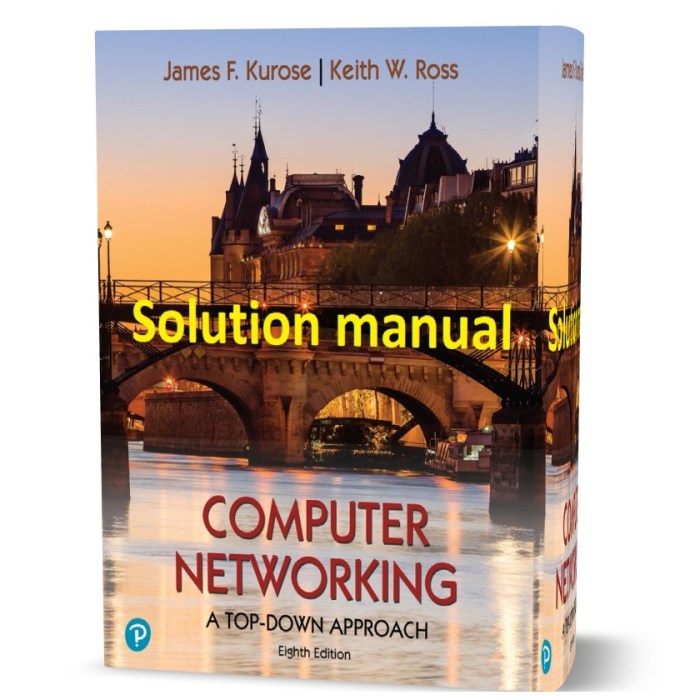Computer networking a top-down approach 8th edition solutions pdf – Delve into the realm of computer networking with the indispensable guide, Computer Networking: A Top-Down Approach, 8th Edition Solutions PDF. This comprehensive resource unravels the complexities of network architectures, protocols, routing, switching, security, and management, empowering you with a profound understanding of this fundamental discipline.
As you embark on this journey, you will unravel the intricacies of network architectures, from LANs to WANs and MANs, and delve into the foundational OSI model that underpins network design. The exploration of network protocols, including TCP, UDP, and IP, will illuminate the mechanisms that facilitate seamless communication between devices.
Introduction
Computer networking is the practice of connecting computers and other devices together to share resources and information. It has become an essential part of modern society, enabling communication, collaboration, and access to information on a global scale.
The purpose of this book is to provide a comprehensive overview of computer networking. It covers the fundamental concepts, architectures, protocols, and technologies used in modern networks.
Network Architectures: Computer Networking A Top-down Approach 8th Edition Solutions Pdf
Local Area Networks (LANs)
LANs are small, private networks that connect devices within a limited geographical area, such as a home, office, or school. They typically use Ethernet technology and operate at high speeds.
Wide Area Networks (WANs)
WANs are larger networks that connect devices over a wider geographical area, such as a city, country, or even the world. They typically use a variety of technologies, including fiber optics, satellite, and wireless.
Metropolitan Area Networks (MANs)
MANs are intermediate in size between LANs and WANs, covering an area such as a city or town. They typically use a combination of LAN and WAN technologies.
The OSI Model
The OSI model is a conceptual framework that divides the network architecture into seven layers. Each layer provides a specific set of services to the layers above and below it.
Network Protocols

Transmission Control Protocol (TCP)
TCP is a reliable transport protocol that provides guaranteed delivery of data between devices. It is used for applications that require reliable data transfer, such as web browsing and file sharing.
User Datagram Protocol (UDP)
UDP is an unreliable transport protocol that provides fast delivery of data without guaranteed delivery. It is used for applications that can tolerate data loss, such as streaming video and voice over IP.
Internet Protocol (IP)
IP is a network layer protocol that provides addressing and routing for data packets. It is the foundation of the Internet and is used by all devices that connect to the network.
Routing and Switching
Routing
Routing is the process of determining the best path for data packets to take through a network. Routers are devices that perform routing.
Switching
Switching is the process of forwarding data packets from one network segment to another. Switches are devices that perform switching.
Routing Algorithms
There are a variety of routing algorithms that can be used to determine the best path for data packets. Some common algorithms include Dijkstra’s algorithm and Bellman-Ford algorithm.
Network Security
Common Network Security Threats
- Malware
- Phishing
- DoS attacks
- Man-in-the-middle attacks
Network Security Measures
- Firewalls
- Intrusion detection systems
- Virtual private networks (VPNs)
Network Management

Importance of Network Management
Network management is essential for ensuring the reliability, availability, and performance of a network. It involves monitoring, troubleshooting, and optimizing the network.
Network Management Components
- Network monitoring tools
- Fault isolation tools
- Performance optimization tools
Emerging Trends in Computer Networking

Cloud Computing
Cloud computing is a model for delivering computing resources over the Internet. It provides access to shared computing resources, such as servers, storage, and software, on a pay-as-you-go basis.
Software-Defined Networking (SDN)
SDN is a new approach to network management that separates the control plane from the data plane. This allows for more flexible and programmable networks.
Network Virtualization, Computer networking a top-down approach 8th edition solutions pdf
Network virtualization is a technology that allows multiple virtual networks to run on a single physical network. This can improve resource utilization and reduce costs.
Common Queries
What is the significance of the OSI model in computer networking?
The OSI model provides a structured framework for understanding the different layers of communication in a network, facilitating efficient network design and troubleshooting.
How does routing differ from switching in computer networks?
Routing determines the path that data takes through a network, while switching forwards data within a specific network segment.
What are the key security threats and vulnerabilities in computer networks?
Common threats include malware, phishing attacks, and unauthorized access, while vulnerabilities can arise from software flaws or misconfigurations.